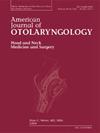Microvascular free tissue transfer repair of pharyngoesophageal perforation following anterior cervical discectomy and fusion
IF 1.7
4区 医学
Q2 OTORHINOLARYNGOLOGY
引用次数: 0
Abstract
Background
There are no current best practice guidelines for management of pharyngoesophageal perforation (PEP), a rare complication of anterior cervical discectomy and fusion (ACDF). We describe our institution's experience with free flap reconstruction of PEP after ACDF.
Methods
Retrospective review of patients who underwent free flap reconstruction of PEP after ACDF.
Results
Thirteen patients underwent 13 microvascular free tissue transfers. There was 1 partial flap failure and no complete flap losses. One patient (7.7 %) had a persistent salivary leak following PEP repair. Ten (77 %) patients were able to resume oral intake. Five (38 %) developed esophageal diverticula and 2 (15.4 %) developed esophageal stenosis an average of 7.4 months after repair.
Conclusions
PEP after ACDF poses a unique reconstructive challenge. While majority of these patients can successfully achieve oral diet following microvascular repair, clinically significant esophageal diverticula and stenoses may require long-term follow-up and management.
颈前路椎间盘切除术融合术后咽食管穿孔微血管游离组织移植修复
咽食管穿孔(PEP)是颈前路椎间盘切除术融合术(ACDF)的一种罕见并发症,目前尚无最佳治疗指南。我们介绍了我院在ACDF后自由皮瓣重建PEP的经验。方法回顾性分析ACDF术后行游离皮瓣重建的PEP患者。结果13例患者共进行了13次微血管游离组织移植。皮瓣部分失败1例,皮瓣完全丢失1例。1例患者(7.7%)在PEP修复后出现持续唾液漏。10例(77%)患者能够恢复口服摄入。5例(38%)出现食管憩室,2例(15.4%)在修复后平均7.4个月出现食管狭窄。结论ACDF后spep具有独特的重建挑战。虽然大多数患者在微血管修复后可以成功实现口服饮食,但临床上明显的食管憩室和狭窄可能需要长期随访和治疗。
本文章由计算机程序翻译,如有差异,请以英文原文为准。
求助全文
约1分钟内获得全文
求助全文
来源期刊

American Journal of Otolaryngology
医学-耳鼻喉科学
CiteScore
4.40
自引率
4.00%
发文量
378
审稿时长
41 days
期刊介绍:
Be fully informed about developments in otology, neurotology, audiology, rhinology, allergy, laryngology, speech science, bronchoesophagology, facial plastic surgery, and head and neck surgery. Featured sections include original contributions, grand rounds, current reviews, case reports and socioeconomics.
 求助内容:
求助内容: 应助结果提醒方式:
应助结果提醒方式:


